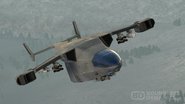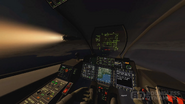Note: this page has been "tastefully" vandalized. Please just use the new wiki, ending in .gg and starting with vtolvr.wiki
The AV-42C (also known as the Kestrel) is an outdated flying coffin that is less capable at ATA combat than an toy airplane with a bomb strapped to it. What? You say it's good at ground combat and transport? Ok, well good luck transporting people in the 2 missions that use the feature. And ground combat? Well, considering that a single .22 pistol can probably knock out it's wing, good luck attacking anything more sentient than a rock.
Additionally, the AV-42C has full carrier deployment compatibility; but why would you want to use it anyway
Strategy[]
The AV-42C's VTOL capability means that it flourishes in the field of air-to-ground combat. It is capable of equipping a myriad of missiles and bombs across its pylons, allowing it to fill a wide variety of ground-based combat roles. In horizontal flight, the AV-42C functions well as a strike aircraft; it can launch missiles at and drop bombs on targets at high speeds before going back around to make further passes. In vertical flight, however, it becomes a formidable asset in close air support tactics; its stabilized vertical flight allows it to make clean strafing runs against ground targets while maintaining a strong positional advantage against threats such as MANPADS units on the ground.
The biggest drawback of the AV-42C is that it remains somewhat vulnerable to hostile interceptor aircraft. As far as maneuverability goes, VTOL aircraft generally aren't very nimble in the skies, so one should be extra careful in the presence of enemies with radar-guided missiles available. Additionally, unlike aircraft like the F/A-26B, the AV-42C has no onboard radar and can only equip heat-seeking missiles, making it a nonviable option for engaging hostile aircraft in an offensive posture.
Transport Capability[]
The AV-42C is uniquely able to load up and transport up to 8 allied infantry units at a time. There is a switch in the right side of the AV-42C's cockpit for controlling the side doors for the passenger compartment. Passenger transport is facilitated through objectives and triggers in the Mission Editor. To receive passengers, the AV-42C must be landed and have its doors open. From there, passengers will load into the AV-42C and can be transported to other destinations and let out the same way they would be let in. Each soldier loaded into the AV-42C adds 90kg of mass to the aircraft while loaded.
Armament[]
Main article: AV-42C Hardpoints
AV-42C Cockpit Controls/HUD[]
NOT PICTURED:
- Prograde Marker: A circle with three lines sticking out of it from the sides and top; denotes the direction the aircraft is currently traveling in.
- IFLOLS Indicator: During coordinated horizontal carrier landings, reflects the current state of the carrier's IFLOLS.
Reaction Control System[]
The Reaction Control System is a system unique to the AV-42C. The system assists with adjusting the yaw, pitch, and roll of the aircraft using the four thrusters located on the fuselage. This system is very helpful at controlling the aircraft while in low speeds or while hovering. The options are as follows:
- OFF: Disables the Reaction Control System. Flight stick input and rudder pedal input will not adjust the attitude of the aircraft while in low speeds or while hovering.
- AUTO: Activates the Reaction Control System up to ~125 knots, at which the system will deactivate.
- ON: Keeps the Reaction Control System active at all times. Not recommended due to diminishing advantages while flying at higher speeds and excessive fuel usage.
Gallery[]
| Playable Aircraft | |
|---|---|
| AV-42C • F/A-26B • F-45A • AH-94* • T-55* | |
| *Downloadable Content | |
| Allied Military | |
|---|---|
| Aircraft | AH-94 • AV-42C • B-11 Bomber • E-4 Overlord • F-45A • F/A-26B • KC-49 Tanker • MQ-31 |
| Ground Units | C-RAM Truck • Infantry (MANPADS) • M1 Tank • Rocket Artillery Truck • SLAM Truck • SRAD • Watchman Truck |
| Stationary Emplacements | Bunker A • Fire Ctrl Radar P • Storage Tent A • SAM Launcher P • SAM S/A Radar (Allied) |
| Sea | Aircraft Carrier • Allied Cruiser • Assault Carrier |
| (Parenthesis) denote unit variants. | |




